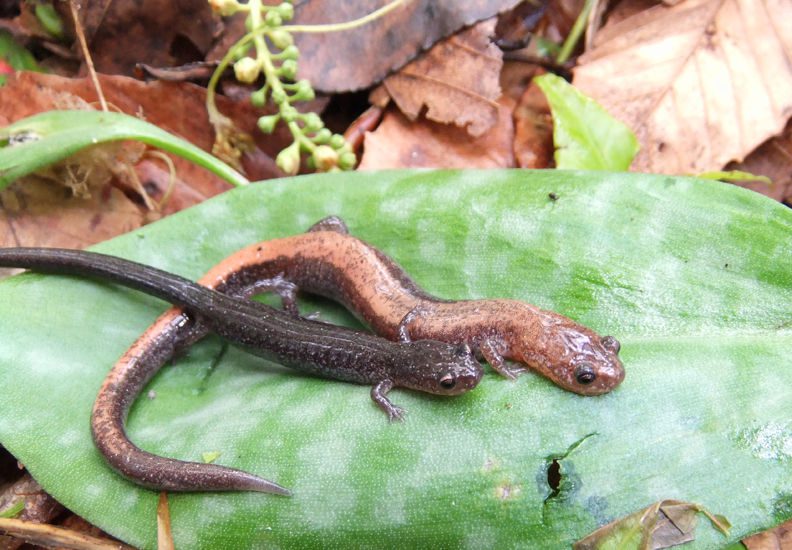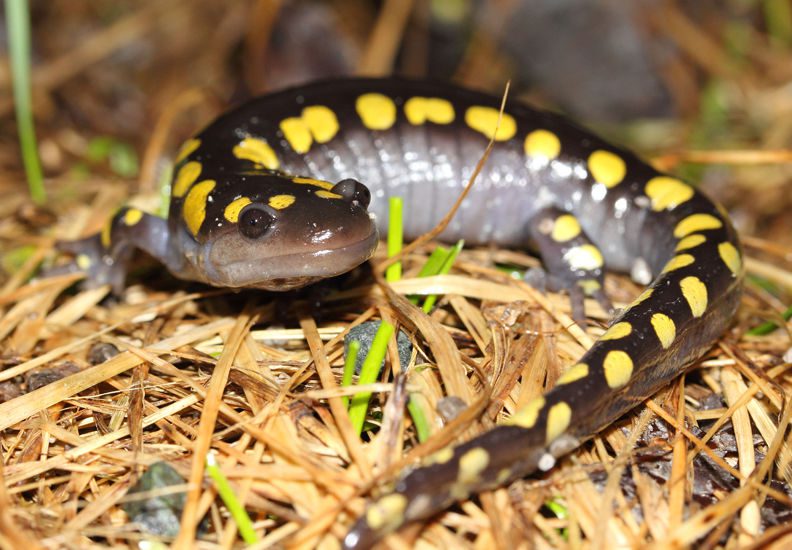by Fred Schueler & Aleta Karstad, Fragile Inheritance Natural History
The Kemptville Campus Education and Community Centre has recently announced that the Campus forests have achieved Forest Stewardship Council (FSC®) Certification through the Eastern Ontario Model Forest’s Forest Certification Program. The announcement was made without reference to the important Amphibian populations which inhabit these woods.
When forest certification was first discussed in the early 1990s, some us suggested that the abundance and diversity of Salamanders, the dominant forest floor vertebrate animals, should make a major contribution to calculations of forest health, in the same way that entomologists suggested that the abundance and diversity of Carabid Ground Beetles could be used. Forest certification went its own way, however, focusing on activities and concerns that were more familiar to foresters, and the biodiversity concerns in most certification schedules are species at risk, rather than taxonomic groups of forest specialists.
Our first summer in what’s now North Grenville was 1979, and one of our major interests was the Salamander populations in the area. We were especially interested in the “monomorphic leadback” populations of the Redback Salamander, Plethodon cinereus. “Redbacks” come in two colour phases, with reddish backs or lead-coloured backs, and most populations include both forms, with the proportion of redbacks increasing in colder climates, and declining through the 20th Century with climatic warming.

Populations are mixed on the Frontenac Arch west of the Rideau Canal, in Quebec, in New York State, and even on islands in the Ottawa and St-Lawrence Rivers, but elsewhere in Eastern Ontario, only the leadback form is found.
In 1979 we spent a good portion of our field effort looking for Salamanders in what’s now North Grenville, and found only Plethodon. While all we found were leadbacks, there were only 19 of them in the entire summer: as many as one might find in an hour in woods along the Ottawa or St-Lawrence rivers. We surmised that these low populations might be due to extensive historical ploughing, grazing, and deforestation of the land, so that ploughed or cattle-trampled clay soils might have lost the natural holes which would allow Salamanders to get below the winter frostline.
This idea was supported when we found Yellow-spotted Salamanders in the now-Agroforestry sugar bush of the Kemptville Campus in 1980, and then, in 1981, on an area of sandy knolls along Cooper Road, near Limerick Forest. In the next few years, we saw this species again in the Campus sugar bush, our colleague Eric Snyder found it there in the early 2000s, and there’s a 2018 record from somewhere nearby in the Ontario Amphibian and Reptile Atlas.


Yellow-spotted Salamanders (Ambystoma maculatum) are abundant on the Canadian Shield, but found only very sporadically on the Eastern Ontario limestone plains. In that first 1980 visit we also found a Blue-spotted Ambystoma, and 12 leadback Plethodon, two thirds as many as we’d found elsewhere in the entire previous summer. In the early 2000s, Eric Snyder also found a Red-spotted Newt (Notophthalmus viridescens) in the Campus sugar bush, so that all the terrestrial Eastern Ontario Salamanders (except the Four-toed, which requires Sphagnum bogs for breeding) have been found there.
Other Amphibians and reptiles we’ve seen in the Campus forests include a few Painted Turtles on Bedell Road, and numerous Garter Snakes. Since 1992, at our auditory listening station just southwest of the sugarbush, we’ve regularly heard Spring Peepers, Grey Treefrogs, American Toads, Wood Frogs, Leopard Frogs, Green Frogs, and Bull Frogs; and in 1992 and 1993 we heard the declining Great Lakes-St-Lawrence Chorus Frog. All of these records are available from the Ontario Amphibian and Reptile Atlas.
So, we have data to affirm a Salamander Certification of the Campus forest, and, after having neglected the site in recent years, we’ll try to again see all the Salamander species in 2020. Management recommendations for Salamanders include care of spring breeding ponds and retention of coarse woody debris. Any one, or any school, who would like to work with us in observing these forest creatures can contact Fred at bckcdb@istar.ca, or Aleta at karstad@pinicola.ca, or (613)299-3107.






